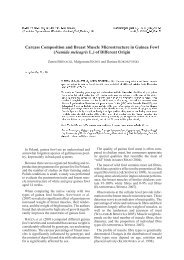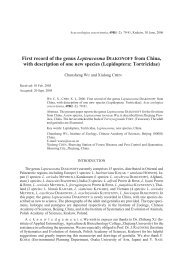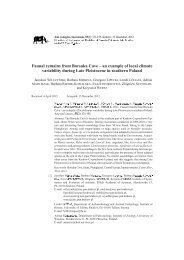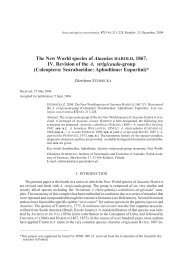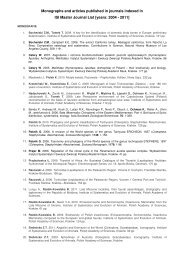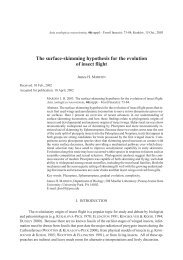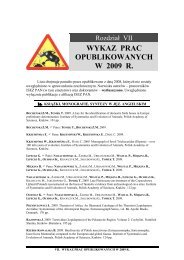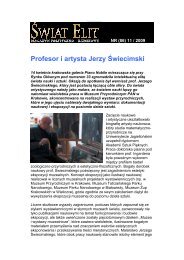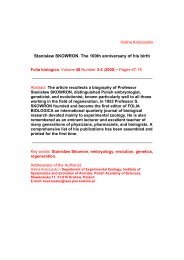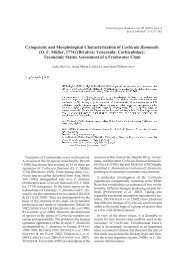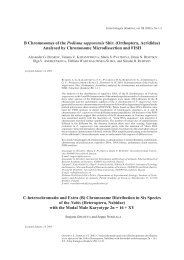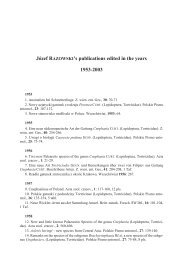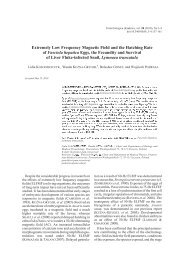Rafael Gioia MARTINS-NETO, Oscar Florencio GALLEGO
Rafael Gioia MARTINS-NETO, Oscar Florencio GALLEGO
Rafael Gioia MARTINS-NETO, Oscar Florencio GALLEGO
You also want an ePaper? Increase the reach of your titles
YUMPU automatically turns print PDFs into web optimized ePapers that Google loves.
Triassic insect fauna from South America<br />
245<br />
Holotype.PZ-CTES nº 5728, housed at PZ-CTES, Argentina. Type locality: 300 m west<br />
of Quebrada del Durazno, south of the Cerro Cacheuta. Mendoza, Argentina, levels EP I and EP II<br />
of MOREL (1994). Type stratum: Upper Section of the Potrerillos Formation. Age: late Middle Triassic<br />
to early Late Triassic.<br />
Australocicada arcucciae <strong>MARTINS</strong>-<strong>NETO</strong> &<strong>GALLEGO</strong> 2001<br />
Fig. 6D<br />
*2001 Australocicada arcucciae <strong>MARTINS</strong>-<strong>NETO</strong> &<strong>GALLEGO</strong>: Fig. 1C.<br />
Holotype. PULR-I nº 256, housed in PULR-I, Argentina. Type locality: Gualo, La<br />
Rioja Province, Argentina. Type stratum: Los Rastros Formation. Age: late Middle Triassic to early<br />
Late Triassic.<br />
Supplementary material.PULR-I nº 266 (Fig. 6C), same data as in<br />
Holotype.<br />
Gualoscytina <strong>MARTINS</strong>-<strong>NETO</strong> &<strong>GALLEGO</strong> n. gen.<br />
Diagnosis.Similar to Saaloscytina BRAUCKMANN and SCHLÜTER, 1993 in general aspect<br />
of venation, differing, however, by ScP long, ending close to apex (short, reaching costal margin<br />
before mid length of wing in Saaloscytina); RP origin close to the wing base; and CuA forking<br />
close to wing base (close to apex in Saaloscytina).<br />
Type species. Gualoscytina mayae <strong>MARTINS</strong>-<strong>NETO</strong> &<strong>GALLEGO</strong> n. sp., by present designation.<br />
Etymology.Named for the Gualo locality and scytina, common suffix for Scytinopteridae.<br />
Gender: feminine.<br />
Discussion.Gualoscytina n. gen. is very similar in general aspects of venation to<br />
Saaloscytina BRAUCKMANN &SCHLÜTER, 1993, described from the Upper Triassic of Germany,<br />
differing however, mainly by ScP morphology: short in Saaloscytina and notably long in Gualoscytina<br />
n. gen. (perhaps a plesiomorphic condition). Also, CuA forks differently: close to the wing<br />
base in Gualoscytina n. gen. (a plesiomorphic condition), with CuA1 and CuA2 long; close to the<br />
apex in Saaloscytina (an apomorphic condition), with CuA1 and CuA2 short.<br />
Gualoscytina mayae <strong>MARTINS</strong>-<strong>NETO</strong> &<strong>GALLEGO</strong> n. sp.<br />
Fig. 6B<br />
Diagnosis.Asforthegenus. Fore wing 9 mm long, foliaceous in shape. All principal<br />
veins with color pattern, contrasting with wing surface.<br />
Etymology.Inhonor of Dr. Cathleen MAY (Newkirk Engler & May Foundation,<br />
Denver, Colorado), who collected some of the material described here and coordinated the NGS<br />
project (grant 5317-94).<br />
Holotype.PULR(I) nº 267, housed in PULR-I, Argentina. Type locality: Gualo, La<br />
Rioja Province, Argentina. Type stratum: Los Rastros Formation (second cycle). Age: late Middle<br />
Triassic to early Late Triassic.<br />
Description.Fore wing 9 mm long, foliaceous in shape. Wing base very narrow.<br />
Apex acuminate. ScP long, reaching Costal margin close to apex. RA long, reaching Apical margin<br />
at apex, with at least one secondary branch. RP origin close to wing base, unbranched. MP long and<br />
sigmoid, originating shortly after origin of RP, also unbranched. CuA forks at same level of MP origin,<br />
two-branched: CuA1 long and sigmoid; CuA2 quite straight. Color pattern consists of darker<br />
color covering all longitudinal veins. Entire surface of the wing rugose, with homogeneously granular<br />
surface.<br />
Discussion.Gualoscytina mayae n. sp. considerably differs from Saaloscytina perreticulata<br />
from the Triassic of Germany in wing shape: foliaceous acuminate in G. mayae n. sp.,



